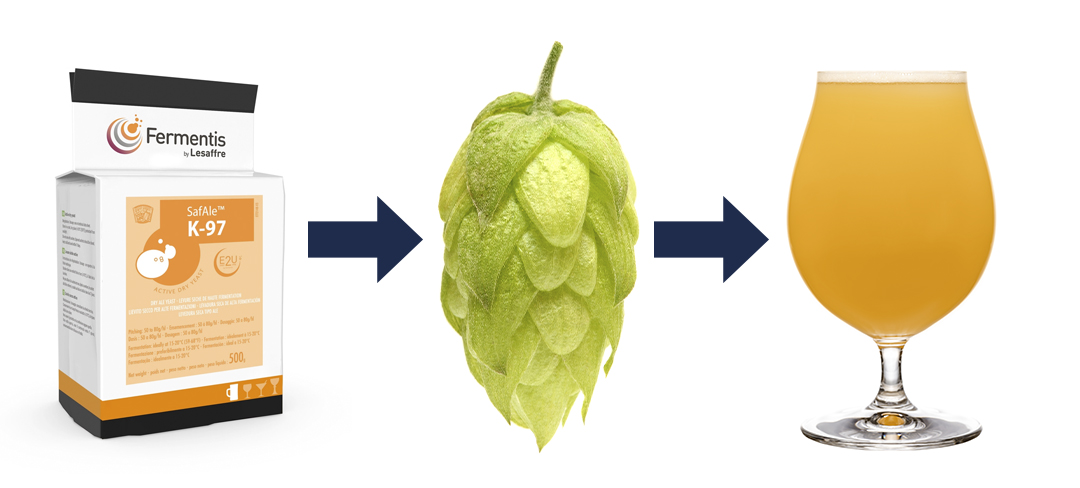Fermentis Helps You Pick the Best Yeast Strains for Biotransformation

Biotransformation is a hot topic. Much like the fundamental, alchemical magic of fermentation itself, biotransformation of hop compounds by yeast offers brewers the potential to create novel compounds beyond the usual suite of variety-specific aromatics.
The activity of yeast cells during active fermentation is key – but which yeast? Our friends from Fermentis are here to help.
The What of Biotransformation: Thiols
“Biotransformation” is a bit of a blanket term that covers a variety of ways that one compound can be transformed into another. The specific biotransformation pathway that brewers are concerned with is the interaction of yeast and hops during fermentation.
During fermentation, the activity of yeast cells can chemically modify extant compounds like geraniol or linalool, or convert organic acids into esters. But the aspect of biotransformation that has most captured the imagination of brewers is the liberation of thiols.

Thiols are sulfur compounds that occur naturally in a variety of plants, including hops and wine grapes. Winemakers have been working with thiols for decades, observing and manipulating their formation during fermentation from precursors in must; but they’re still a new frontier for brewers.
Thiols make up a tiny fraction of the aromatic oils in a hop cone – less than 1%. Although low in concentration, they’re highly reactive and not always desirable (think cabbage and onion). However, some thiols are capable of imparting intense fruity flavors (think tropical, citrus, and berry). Because these compounds have a very low perception threshold, biotransformation becomes an intriguing proposition to brewers on a budget or working with limited access to proprietary hop varieties: thiols represent the possibility of yielding high aromatic impact from a small amount of raw material.

Some key thiols with molecular structure, aroma profiles, and sensory thresholds – image courtesy Fermentis by LeSaffre
Brewing scientists still have much to learn about thiols. Thiol potency is affected by hop variety and provenance, and likely also by harvest maturity, processing, and storage. And because thiols are a family of compounds that exist as a trace within myriad other sensory-active molecules in the hop flower, studying them is a little like looking for the proverbial needle in a haystack. Or playing hide-and-seek with Houdini. Or throwing darts in a dark room.
The How of Biotransformation: Enter Saccharomyces
Thiols appear in either free or bound form. Free thiols don’t require biotransformation to activate their tropical, fruity aromatics, and hops with the highest levels of free thiols tend to be more expensive and/or proprietary.
Bound thiols exist as a sulfur atom bound to a hydrogen atom – in order for bound thiols to become perceptible and impact beer aroma, enzymatic action from yeast cells is required.
To liberate thiols at a level that will affect beer sensory, you need a yeast strain genetically equipped with the necessary enzyme.
Practical Magic and SafAle™
Fermentis conducted a series of trials to determine which of their most popular ale strains were best for biotransformation in the fermentation vessel. Their test parameters, results, and analysis can be seen in full in their presentation from a Brewers Association power hour – but we’ll summarize the findings here.
SafAle™ K-97 boasts the highest thiol release efficiencies across the tested strains; S-04, S-33, and BE-256 are strong candidates for achieving biotransformation via esterification.


Trial results by strain – image courtesy Fermentis by LeSaffre
To get the most bang for your biotransformative buck, hop selection is as important as yeast: look for varieties like Cascade, Hallertau Blanc, Nugget, Perle, Polaris, Saaz, or Summit.
Go Deeper:
Product specification sheets, information, and recipes on www.fermentis.com
Follow Fermentis – www.facebook.com/Fermentis and @Fermentis
10 Little-Known Facts About Yeast
Fermentis Yeast & Bacteria from BSG
Questions? Orders? Get in touch!